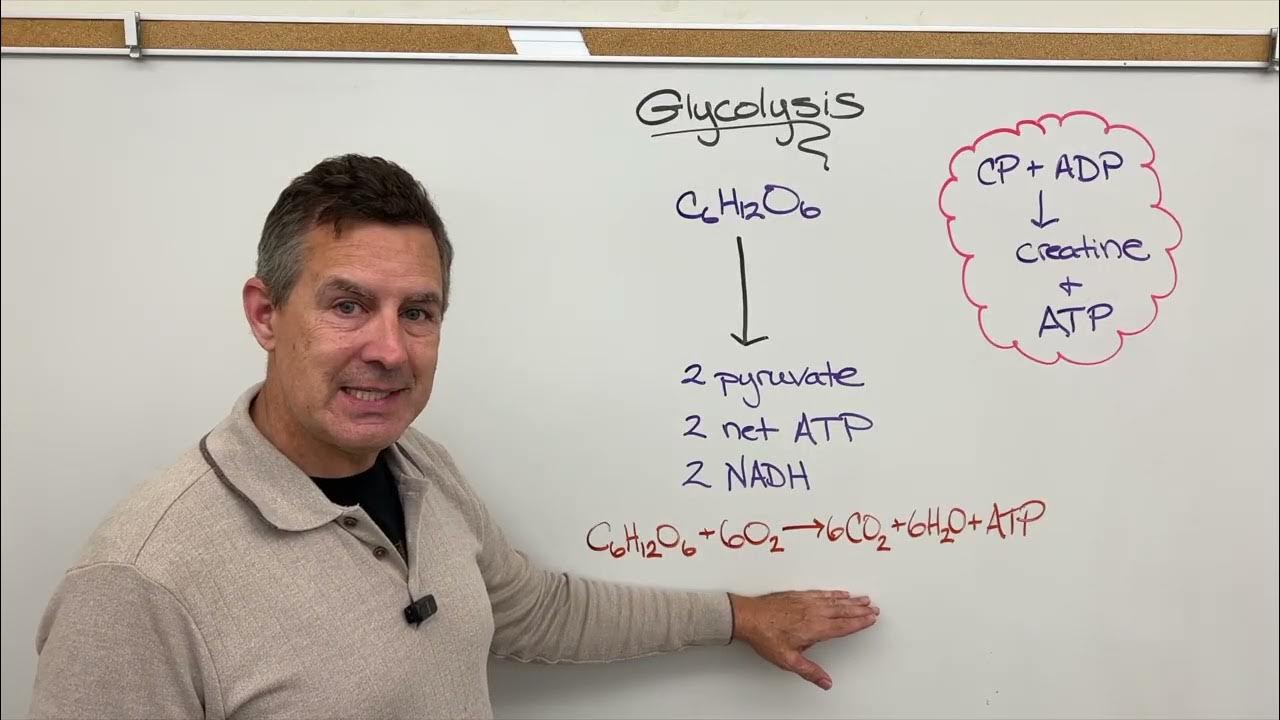Bahas Lengkap Fosforilasi Oksidatif | Transport elektron dan Kemiosmosis
Summary
TLDRThis video provides a comprehensive guide to aerobic respiration, focusing on the final stages: oxidative phosphorylation, electron transport, and chemiosmosis. It explains the structure and role of mitochondria in ATP production, detailing the electron transport chain (ETC) and the movement of electrons and protons across the inner mitochondrial membrane. The video compares the oxidation of NADH and FADH2 and their effects on ATP generation. It also covers the differences in ATP yield between prokaryotic and eukaryotic cells. This video is an in-depth resource for understanding cellular energy production through respiration.
Takeaways
- 😀 The video is a continuation of a series on aerobic respiration on the Kabio channel.
- 😀 It explains the stages of aerobic respiration, including glycolysis, oxidative decarboxylation, and the Krebs cycle.
- 😀 NADH and FADH2 are produced in earlier stages and play a key role in ATP production during oxidative phosphorylation.
- 😀 The video focuses on two key stages of aerobic respiration: electron transport and chemiosmosis.
- 😀 Mitochondria have two membranes, with the inner membrane forming folds called cristae to increase surface area for electron transport.
- 😀 The inner membrane is specialized with proteins and lipids that facilitate proton pumping and electron transfer, essential for ATP production.
- 😀 Complexes 1 to 4 in the electron transport chain help transfer electrons and pump protons, eventually producing water as a byproduct.
- 😀 NADH and FADH2 are oxidized to release high-energy electrons, which are passed through the protein complexes to oxygen, forming water.
- 😀 ATP synthase utilizes the proton gradient created by the electron transport chain to synthesize ATP during chemiosmosis.
- 😀 The final ATP yield from aerobic respiration includes 32 ATP in prokaryotes and 30 ATP in eukaryotes due to the transport of pyruvate requiring 2 ATP.
Q & A
What is the main focus of this video?
-The video focuses on the process of oxidative phosphorylation in aerobic respiration, particularly the electron transport chain and chemiosmosis.
What is the function of the mitochondrion's inner membrane in the process of oxidative phosphorylation?
-The inner mitochondrial membrane contains proteins involved in the electron transport chain, facilitating the movement of electrons and pumping protons, which are essential for ATP synthesis.
How does the structure of the inner mitochondrial membrane contribute to its function?
-The inner membrane is folded into cristae, which increases surface area for efficient electron transport and ATP production. It is impermeable to ions, ensuring proper proton gradient maintenance.
What are the key proteins involved in the electron transport chain?
-The key proteins in the electron transport chain include Complexes I to IV, each performing different roles in electron transfer and proton pumping, along with ubiquinone and cytochrome C as electron carriers.
What is the role of NADH in the electron transport chain?
-NADH donates high-energy electrons to Complex I, where they are passed through the chain, facilitating the pumping of protons and ultimately helping to generate ATP.
Why does FADH2 contribute less ATP compared to NADH?
-FADH2 enters the electron transport chain at Complex II, which does not pump protons. As a result, it generates fewer protons for ATP production, leading to the formation of 1.5 ATP per FADH2 compared to 2.5 ATP per NADH.
What happens to the electrons at Complex IV of the electron transport chain?
-At Complex IV, the electrons are transferred to oxygen, which is the final electron acceptor, and combine with protons to form water, a key byproduct of aerobic respiration.
What is chemiosmosis and how does it contribute to ATP production?
-Chemiosmosis is the process where protons flow back into the mitochondrial matrix through ATP synthase, generating the energy needed to combine ADP and inorganic phosphate to produce ATP.
Why is there a difference in ATP production between prokaryotic and eukaryotic cells?
-In prokaryotes, respiration occurs in the cytoplasm and cell membrane, while in eukaryotes, respiration occurs in the mitochondria. The need to transport pyruvate into the mitochondria in eukaryotes consumes 2 ATP, reducing the total ATP output compared to prokaryotes.
What are the byproducts of the electron transport chain and how are they formed?
-The byproducts of the electron transport chain are water and a proton gradient. Water is formed when oxygen accepts electrons and combines with protons, while the proton gradient is created by the pumping of protons across the membrane.
Outlines

This section is available to paid users only. Please upgrade to access this part.
Upgrade NowMindmap

This section is available to paid users only. Please upgrade to access this part.
Upgrade NowKeywords

This section is available to paid users only. Please upgrade to access this part.
Upgrade NowHighlights

This section is available to paid users only. Please upgrade to access this part.
Upgrade NowTranscripts

This section is available to paid users only. Please upgrade to access this part.
Upgrade Now5.0 / 5 (0 votes)





